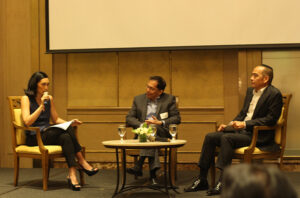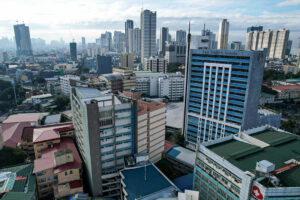THE Bangko Sentral ng Pilipinas (BSP) is back on its easing track, analysts said, with rate cuts seen in the second half of the year.
“Given current projections of ‘target-consistent’ inflation and the outlook of a fragile global economy, the BSP will likely continue easing monetary conditions,” the Metrobank Research and Market Strategy Department said in a report.
It noted that the central bank will also likely maintain “a cautious approach as markets brace for the impacts of the trade war instigated by Donald J. Trump.”
The BSP on Thursday resumed its rate-cutting cycle, delivering a widely expected 25-basis-point (bp) rate cut. This brought the target reverse repurchase rate (RRP) to 5.5% from 5.75% previously.
BSP Governor Eli M. Remolona, Jr. signaled further rate reductions this year as the benchmark is still “slightly restrictive.”
However, he noted rate cuts will still likely be delivered in “baby steps” or in 25-bp increments. He said the central bank is also unlikely to lower rates at every policy meeting this year.
Mr. Remolona also told Bloomberg TV on Friday they would only consider cutting at every meeting in a “hard-landing scenario,” which was unlikely.
For its part, Metrobank expects the BSP to deliver one more 25-bp cut this year.
“After today’s 25-bp cut, we expect one more similar-sized cut this year, which will bring the target RRP to 5.25% by yearend.”
“Weak economic growth, however, could give space for the BSP to squeeze in an additional 25-bp rate reduction toward the end of the year. This is increasingly becoming our baseline scenario,” it added.
HSBC Global Research economist for ASEAN (Association of Southeast Asian Nations) Aris D. Dacanay said the central bank has “swung into dovishness.”
The BSP last week said it has shifted towards a “more accommodative” monetary policy stance.
Mr. Dacanay expects the Monetary Board to reduce rates two more times this year, through 25-bp cuts at each of its August and December meetings. This would bring the key rate to 5% by end-2025.
“This implies that the BSP will cut in alternate rate-setting meetings (i.e. no rate cuts in June and October),” he added.
There are four more Monetary Board policy meetings this year, with the next slated for June 19.
“The BSP will likely employ a very cautious approach when easing given the large degree of uncertainty in global trade policy and, interrelatedly, the risk of FX (foreign exchange) volatility,” Mr. Dacanay said.
ANZ Research likewise expects the central bank to cut rates in the third and fourth quarters at 25 bps each.
“Given the improvement in the inflation outlook and the downside risks to growth, we now expect two more rate cuts by the BSP, bringing the policy rate to 5% in 2025,” it said in a report.
Meanwhile, Nomura Global Markets Research sees an additional 75 bps worth of rate cuts this year.
“With BSP also acknowledging that growth headwinds are increasing due to global trade policy uncertainty, along with our new inflation forecasts, we now forecast another 75 bps of rate cuts, taking the terminal rate to 4.75% this year.”
Nomura also noted the possibility of another 25-bp cut “if inflation surprises lower.”
INFLATION OUTLOOKAnalysts said the easing inflation outlook is one of the main reasons behind the expectation for further rate cuts.
For its part, Metrobank expects headline inflation to settle at 3% this year.
The central bank slashed its risk-adjusted inflation forecasts to 2.3% in 2025 from 3.5% previously and to 3.3% in 2026 from 3.7% previously.
The latest data from the local statistics authority showed inflation slowed to 1.8% in March, its slowest rate in nearly five years.
Mr. Remolona also told Bloomberg TV that they are considering reviewing their current inflation targets as they are “not sure whether it’s at the right level.”
The current 2-4% target band’s midpoint is at 3%, which may be “a bit high.”
The central bank is reviewing its projections and could possibly adjust its target to 2.5%, he added.
“With the inflation outlook benign, the tariffs provide an added rationale for more monetary easing,” Nomura said.
Metrobank flagged the risk of imported inflation amid global trade uncertainties.
“Potentially higher global commodity prices could seep through to the domestic market,” it added.
Mr. Trump last week announced a 90-day freeze on the steep new reciprocal tariffs on most of its trading partners but kept the baseline rate of 10%.
“There is a downside risk of the easing cycle being done faster,” Mr. Dacanay said, citing the possibility of deteriorating global growth conditions.
“The US reciprocal tariffs will likely take a toll on global growth. But the degree of the impact is highly uncertain with tariff policies changing by the week.”
Mr. Dacanay said that if the interest rate differential widens between the BSP and US Federal Reserve, this could prompt the former to ease rates.
“This will be the case if US inflation rises due to higher tariffs, while inflation in the Philippines remains low due to excess capacity of manufacturers or exporters around the world on the back of low US demand.”
Some economists now expect the US Federal Reserve to delay the resumption of its easing cycle until later this year after pausing in January.
“If foreign investors demand Philippine assets to insulate themselves from global financial market volatility, the peso might exhibit resilience, which, in turn, could give the BSP room to cut policy rates faster or more than the Fed,” Mr. Dacanay added.
The peso closed at P56.97 against the dollar on Friday, strengthening from the P57.35 finish on Thursday.
“Given the BSP’s narrower interest rate differential of 100 bps with the Federal Reserve, USD/PHP may be pressured in the near term but is still expected to settle at P57.70 by yearend,” Metrobank said.
The BSP’s recent reserve requirement cut will also pave the way for its monetary easing.
“The continued policy easing along with the reduction in the reserve requirement ratio which took effect in March should provide a more accommodative policy environment to further boost private consumption and investment,” Metrobank said.
Effective late last March, the BSP cut the reserve requirement ratio (RRR) of universal and commercial banks and nonbank financial institutions with quasi-banking functions by 200 bps to 5% from 7%.
“Recent cuts to the RRR are still feeding through the system and helping policy transmission,” Nomura added. — Luisa Maria Jacinta C. Jocson






